You are currently browsing the tag archive for the ‘Madagascar’ tag.
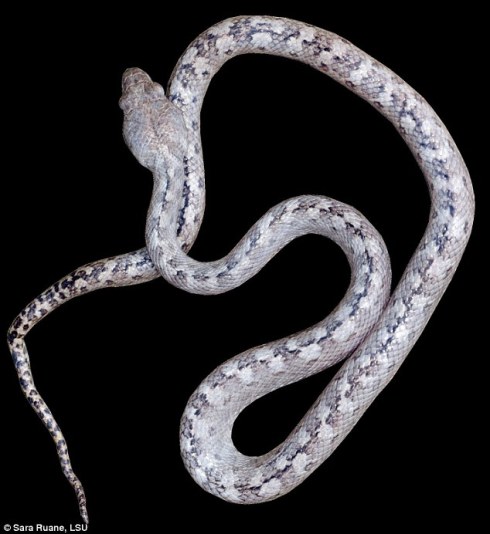
Once again, Ferrebeekeeper heads off to the mysterious micro-continent of Madagascar. This time we are not looking for flags or lemurs, but instead for a newly discovered snake, Madagoscarophis lolo, AKA “the Madagascar ghost snake.” The ghost snake was discovered this year by an international team of researchers from the American Museum of Natural History, the Université de Mahajunga, and LSU. The gray snake with dark gray stipples was discovered at the limestone Tsingy rocks of Ankarana Reserve. This instantly explains why the species was hitherto undiscovered: this snake looks like it would be invisible on the polished wooden floor of a brightly lit library–much less in an impassible wasteland of giant limestone spikes the exact same color that it is. The ghost snake is a species of cat-eyed snakes, little predators with vertical pupils which are active at twilight and at night. The ghost snake seems to be crepuscular…but so far we don’t know too much about it other than that…
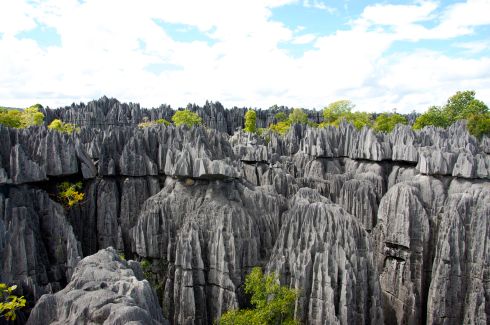
It is leap day! Every four years the niceties of the calendar give us this extra day. In the past, leap day has caused me to reflect about history, the calendar, and the ineluctable nature of time in general, but this year I am going a different direction. Instead of concentrating on the calendar aspect of the day, we will concentrate instead on “leaping.” And from there it is a short cognitive leap to the microcontinent of Madagascar where we find the masters of leaping, the lemurs.

Ring-tailed Lemur jumping (Lemur Catta) photo by Luc V. de Zeeuw
Lemurs are strepsirrhine (wet-nosed) primates endemic to the island of Madagascar. They are ancestral primates—the monkeys, apes, and hominids evolved from them (though of course these branches diverged in the Eocene and the lemurs have been evolving in their own directions for 50 million years). In fact, let me say that last sentence differently and better: monkeys (and apes and people) descended from a very lemur-like ancestor.
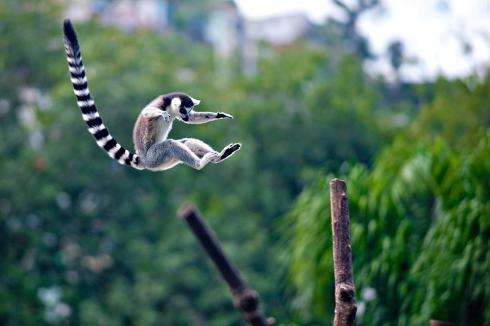
There are nearly 100 species of lemurs and they have spread through all sorts of evolutionary niches in Madagascar. It is hypothesized that they reached the island micro-continent by rafting there on masses of floating wood and vegetation. On Madagascar they were free to evolve in their own direction, as other primates back in the ultracompetitive African homeland went down different pathways. When humankind finally reached Madagascar 2000 years ago (from Indonesia!) there were even more strange lemurs, including some as large as gorillas, but the violent humans quickly snuffed them out (and indeed we are rapidly eating the remaining smaller lemurs out of house and home as well (or just eating them outright).
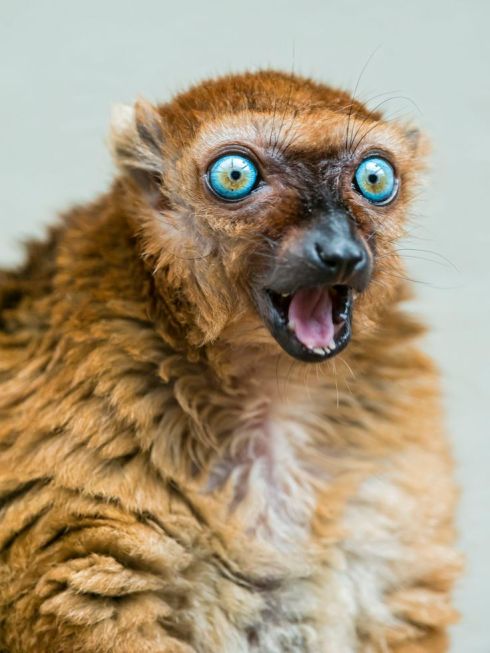
Female Sclaters lemur with open mouth (photo by “Tambako the Jaguar”)
Lemurs live in many habitats and specialize in many lifestyles. They are diurnal or nocturnal or crepuscular. They are fructivores, or herbivores, or insectivores. Some are omnivorous. With many different lifestyles come different habitats, but lemurs, like most other primates tend to be arboreal. While some lemurs imitate lorises and sloths and move with deliberate glacial slowness, the majority of lemurs have a different and far showier way of getting around—they leap from tree to tree like acrobats.
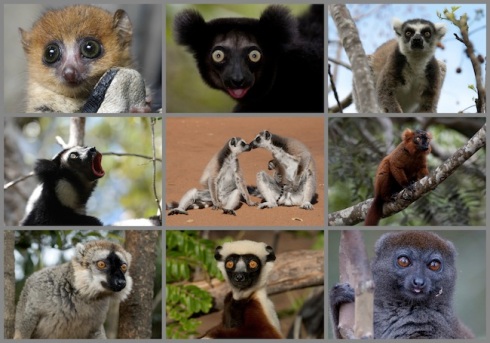
Perhaps I should say acrobats are like lemurs. Not only were the latter here first, but they are also capable of thrilling flights that would cause the most air-worthy flying Wallenda to fall down dead (literally). Using their long powerful back legs, lemurs hurl themselves into the air and then flatten out. They can thus leap up to 10 m (33 feet). And this is not an isolated leap. They can leap again and again and again…thus springing through whole jungles in a series of breathtaking bounds. The real masters of leaping—the ring-tailed lemur and Verreaux’s sifaka, hardly seem suited for any other sort of locomotion. When Verreaux’s sifaka is stranded in a tree island and is forced to cross open ground the poor creature looks quite ludicrous (see the gif below). It holds its arms above its head and leaps plaintively and swiftly across the hated land. But Verreaux’s sifaka looks utterly at home in its preferred habitat—hurling itself between spiny trees covered with razor sharp needles.

The more I read about lemurs, the more I realize I will have to come back and write more about them. It may be four years before the next leap day, but we will be back to lemurs before then!

At the end of last month (October 2015), marine researchers in the Indian Ocean captured the first ever moving images of Omura’s whale (Balaenoptera omurai) a “dwarf” rorqual about which very little is known. I put “dwarf” in quotation marks because Omura’s whale is still a rorqual, a family which includes the largest animals to have ever lived. Adult Omura’s whales range in length from 9.6 to 11.5 meters (31.5 to 37.7 feet)—not exactly a miniature animal.
The whale is mysterious because it is rare. The specimens which were observed (or killed) were thought to be a small subspecies of Bryde’s whale. Only in 2003 did Japanese cetologists demonstrate incontrovertibly that the whale was a separate species (largely through genetic evidence preserved from specimens taken in infamous hunts/research expeditions).
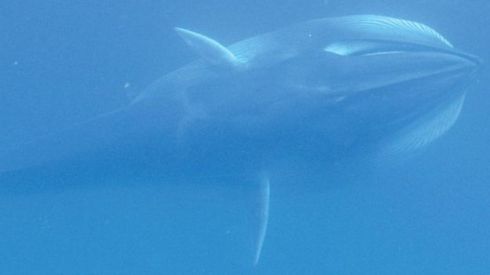
An Omura’s whale underwater lunge feeding (photo by Cerchio et al. 2015, Royal Society Open Science)
Insomuch as we know anything about it, the Omura’s whale (which is named in honor of a famous Japanese whale scientist) is like other rorquals. It is a huge pelagic filter feeder which captures plankton or small fish and invertebrates in its great baleen mouth and strains the water out. It superficially resembles Bryde’s whale, however DNA reveals that it is an early offshoot from the rorqual lineage (its skeleton also differs greatly from Bryde’s whale)
We didn’t even know this was a species until 12 years ago—which illustrates how vast and unknown our own oceans still are. The Omura’s whales in the video/film were spotted in the Indian Ocean off the coast of Madagascar. Hopefully they are not as isolated as they seem and the oceans will continue to be graced by this mysterious creature far into the future.
Behold, the fossa (Cryptoprocta ferox), the top predator of Madagascar (exempting, as always, our own very predatory kind). The fossa weighs between 5.5 and 8.5 kg (12 to 20 pounds) and lives mostly on primates—namely the lemurs which are everywhere indigenous to the strange micro-continent. Since lemurs are brilliant climbers, the fossa is also an arboreal specialist and it can run down trees headfirst and execute stunning acrobatic leaps which would make a trapeze artist blanche and retire. The predator prefers hunting lemurs but it also dines on bats, reptiles, tenrecs, rodents, birds, and whatever other small living creatures it can catch.
The first time I saw footage of a fossa, my mind kept insisting it was a cat…no a weasel…no a stretched-out bear. Its extreme similarity to familiar predators combines in a sinister way with its lithe alien movements to make it seem very peculiar. I wonder too if some desperate little tree-creature part of our brain doesn’t respond badly to the fossa-for it is difficult to look away from one in action, and it has many similarities with analogous predators encountered by our arboreal forbears. It hunts both by day and night. It climbs, swims, runs, and lurks with great skill–so there is never any true safety for animals which it preys on.
According to taxonomy and genetics, the fossa is indeed closely related to cats, bears, weasels, seals, and all of the other members of the order Carnivora. The fossa is perhaps most closely related to viverrids (the civets and genets), but it shares many features with felines as well, and may be considered to be descended from an intermediary form. The ancestor of the fossa first came to Madagascar around 20 million years ago, during the Miocene as forests dwindled and grasslands spread on Africa and as Madagascar drifted particularly close to the great continent.
Fossas live to around twenty years of age. They have social lives similar to cats, and even have similar vocalizations. Fossas of both genders have bizarre elongated external genitals (and the male member is equipped with backwards pointing spines). Additionally, they secrete an orange substance which “colors their underparts”. You can go look up details and pictures on your own time. The mother fossa gives birth to litters of two to four (though occasionally as few as one or as many as six) cubs, which mature slowly. Physical maturity is not reached until the age of two and the young fossa do not reproduce until a year or two after that. Fossa have always been solitary and rare, but human habitat-destruction (among other ills) seems to be making them even scarcer.
I started writing this post imagining that the fossa would be esoteric and largely unknown to most of my readers, but the internet quickly revealed that it is a film star and a media darling of our age. Apparently a fossa was the villain of “Madagascar” an animated children’s film about lemur society and a zoo-breakout. How did I miss an animated movie about lemurs? I’m going to go watch that right now.
This is the flag of Madagascar: three rectangles of white, red, and green. The rectangles are nearly equal in size (although the vertical white rectangle is slightly wider). The flag has been the symbol of Madagascar since 1958—which means it was adopted two years before the island nation became independent of the French empire in 1960.
 Madagascar is an ancient island subcontinent which is currently located in the Indian Ocean just east of Sub Saharan Africa (it has actually moved around a great deal during geological history–but that is irrelevant for a post about the national flag). The large island was colonized by two waves of human inhabitants. The first Madagascar people were Austronesians who arrived between 350 BC and 550 AD via boat from the island of Borneo. Boneo and Madagascar are about 7,600 kilometers (4760 miles) apart, so this was no trifling feat of navigation! The second main wave of human colonization took place around 1000 AD, when many Bantu people crossed the Mozambique channel–which is a more manageable boat journey of 460 km (286 miles).
Madagascar is an ancient island subcontinent which is currently located in the Indian Ocean just east of Sub Saharan Africa (it has actually moved around a great deal during geological history–but that is irrelevant for a post about the national flag). The large island was colonized by two waves of human inhabitants. The first Madagascar people were Austronesians who arrived between 350 BC and 550 AD via boat from the island of Borneo. Boneo and Madagascar are about 7,600 kilometers (4760 miles) apart, so this was no trifling feat of navigation! The second main wave of human colonization took place around 1000 AD, when many Bantu people crossed the Mozambique channel–which is a more manageable boat journey of 460 km (286 miles).
The red and the white of the Madagascar flag are said to represent both the Merina kingdom (which fell to the French in 1896) and the colors of the flag of Indonesia (red and white) which was where the first Madagascar people hailed from. The Merina people are highlanders who culturally dominated the island for centuries.
The green of the flag is said to represent the Hova people—the free peasantry. During the Merina kingdom, society was divided into three classes: Merina aristocrats, Hova peasants, and slaves (coincidentally these slaves were obtained from raids on the Makua people during the 19th century). The Hova apparently played a large part in the 1950s independence movement against the French colonial authorities.
 In conclusion, the more I have studied the Madagascar flag, the less sure I am that it means anything. I feel like some graphically inclined revolutionary might have made up the whole thing in 1958 because he liked the colors. More importantly however, I have become fascinated by the strange human history of this perplexing mini continent which was inhabited so very recently.
In conclusion, the more I have studied the Madagascar flag, the less sure I am that it means anything. I feel like some graphically inclined revolutionary might have made up the whole thing in 1958 because he liked the colors. More importantly however, I have become fascinated by the strange human history of this perplexing mini continent which was inhabited so very recently.













